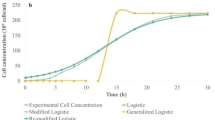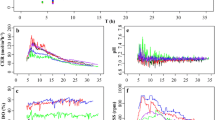Abstract
Application of Generalized Additive Models (GAMs) for modelling of Glutamate fermentation process was proposed in this paper. There were so many variables in fermentation process and insignificant variables that might worsen pre-built model performance, so experiments of choosing significant variables were firstly carried out. One new model was constructed after choosing time (Time), dissolved oxygen (DO) and oxygen uptake rate (OUR) as significant variables. The simplified relationships that could reflect each variable effect in fermentation process between Time, DO, OUR and GACD were investigated using the constructed model. The integrated relationships that could provide theoretical base to implement control and optimize in fermentation processes between Glutamate and other significant variables were also explored. Normally, fermentation model was specific with the character of poor generalization, because of the complications of fermentation process, high degree of time-varying and batch changing. However the new model fitting results indicated the advantages, in term of non-parameter identification, prediction accuracy and robust ability. So the new model in this paper was satisfiedly characteristic of generalization. The advocated modelling method potentially supplies an alternative way for optimization and control of fermentation process.
Access this chapter
Tax calculation will be finalised at checkout
Purchases are for personal use only
Preview
Unable to display preview. Download preview PDF.
Similar content being viewed by others
References
Kinoshita, S.: Glutamic acid bacteria. In: Demain, A.L., Solomon, N.A. (eds.) Biology of Industrial Micro-organisms, pp. 115–142. Benijamin Cummings, London (1985)
Zhang, C.Y., Shi, Z.P., Gao, P., Duan, Z.Y., Mao, Z.G.: On-line prediction of products concentrations in glutamate fermentation using metabolic network model and linear programming. Biochemical Engineering Journal 25, 99–108 (2005)
Gebert, J., Radde, N.: A new approach for modeling procaryotic biochemical networks with differential equations. Computing Anticipatory Systems 839, 526–533 (2006)
Gonzalez, R., Murarka, A., Dharmadi, Y., Yazdani, S.S.: A new model for the anaerobic fermentation of glycerol in enteric bacteria: Trunk and auxiliary pathways in Escherichia coli. Metabolic Engineering 10, 234–245 (2008)
Jimenez-Hornero, J.E., Santos-Duenas, I.M., Garcia-Garcia, I.: Structural identifiability of a model for the acetic acid fermentation process. Mathematical Biosciences 216, 154–162 (2008)
Vazquez, J.A., Murado, M.A.: Unstructured mathematical model for biomass, lactic acid and bacteriocin production by lactic acid bacteria in batch fermentation. Journal of Chemical Technology and Biotechnology 83, 91–96 (2008)
Gebert, J., Radde, N., Faigle, U., Strosser, J., Burkovski, A.: Modeling and simulation of nitrogen regulation in Corynebacterium glutamicum. Discrete Applied Mathematics 157, 2232–2243 (2009)
Shimizu, K., Furuya, K., Taniguchi, M.: Optimal Operation Derived by Greens Theorem for the Cell-Recycle Filter Fermentation Focusing on the Efficient Use of the Medium. Biotechnology Progress 10, 258–262 (1994)
Bause, M., Merz, W.: Higher order regularity and approximation of solutions to the Monod biodegradation model. Applied Numerical Mathematics 55, 154–172 (2005)
Dette, H., Melas, V.B., Pepelyshev, A., Strigul, N.: Robust and efficient design of experiments for the Monod model. Journal of Theoretical Biology 234, 537–550 (2005)
Pollard, J.F., Broussard, M.R., Garrison, D.B., San, K.Y.: Process Identification Using Neural Networks. Computers & Chemical Engineering 16, 253–270 (1992)
Ungar, L.H., Powell, B.A., Kamens, S.N.: Adaptive Networks for Fault-Diagnosis and Process-Control. Computers & Chemical Engineering 14, 561–572 (1990)
Kishimoto, M., Yoshida, T.: Application of Fuzzy Theory on Fermentation Processes. Hakkokogaku Kaishi-Journal of the Society of Fermentation Technology 69, 107–116 (1991)
Georgieva, O., Wagenknecht, M., Hampel, R.: Takagi-Sugeno fuzzy model development of batch biotechnological processes. International Journal of Approximate Reasoning 26, 233–250 (2001)
Hastie, T., Tibshirani, R.: Generalized Additive Models. Chapman and Hall, Boca Raton (1990)
Gu, C.: Cross-validating non-Gaussian data. Journal of Computational and Graphical Statistics 1, 169–179 (2002)
Wood, S.N.: Generalized Additive Models: An Introduction with R. Chapman and Hall/CRC, Boca Raton (2006)
Wood, S.N.: Fast stable direct fitting and smoothness selection for generalized additive models. Journal of the Royal Statistical Society Series B-Statistical Methodology 70, 495–518 (2008)
R Development Core Team, R: A Language and Environment for Statistical Computing. R Foundation for Statistical Computing, Vienna, Austria (2008)
He, S., Mazumdar, S., Arena, V.C.: A comparative study of the use of GAM and GLM in air pollution research. Environmetrics 17, 81–93 (2006)
Health Effects Institute, Revised analysis of time-series studies of air pollution and health: Special report, Boston, Mass (2003)
Cox, M.E., Moss, A., Smyth, G.K.: Water quality condition and trend in North Queensland waterways. Marine Pollution Bulletin 51, 89–98 (2005)
Morton, R., Henderson, B.L.: Estimation of nonlinear trends in water quality: An improved approach using generalized additive models, Water Resources Research 44 (2008)
McCullagh, P., Nelder, J.A.: Generalized Linear Models. Chapman & Hall, London (1989)
Author information
Authors and Affiliations
Editor information
Editors and Affiliations
Rights and permissions
Copyright information
© 2010 Springer-Verlag Berlin Heidelberg
About this paper
Cite this paper
Liu, C., Ju, X., Pan, F. (2010). Statistical Modelling of Glutamate Fermentation Process Based on GAMs. In: Li, K., Jia, L., Sun, X., Fei, M., Irwin, G.W. (eds) Life System Modeling and Intelligent Computing. ICSEE LSMS 2010 2010. Lecture Notes in Computer Science(), vol 6330. Springer, Berlin, Heidelberg. https://doi.org/10.1007/978-3-642-15615-1_57
Download citation
DOI: https://doi.org/10.1007/978-3-642-15615-1_57
Publisher Name: Springer, Berlin, Heidelberg
Print ISBN: 978-3-642-15614-4
Online ISBN: 978-3-642-15615-1
eBook Packages: Computer ScienceComputer Science (R0)




